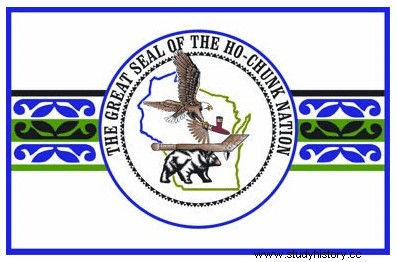Representatives of the United States Bureau of Indian Affairs and chiefs of the Dakota (Eastern Sioux) signed several treaties in the 1850s in which the Indians ceded large tracts of land in the Minnesota Territory (it would become a state on May 11, 1858) in exchange for financial compensation and the provision of goods . However, when the treaties reached the Senate for ratification, a large part of the compensation was rejected and others fell into the pockets of third parties, and even reduced the territory that was going to remain for the Dakota along the Minnesota River. Little Raven and other chiefs of the tribes traveled to Washington DC to demand the application of the signed treaties... but the great White Chief turned a deaf ear. Still, they held on.

Little Raven
With the arrival of the settlers in the new territories, everything changed for the Dakota:the felling of the forests, the division of the prairie land and the indiscriminate fishing in the rivers drastically reduced the population of bison, elk, deer... If it decreased hunting, decreased food and skins to sell. In addition, the annual payments that the government had to face were increasingly delayed, and when they arrived they went directly into the pockets of local merchants from whom the Indians bought on credit in order to survive. Under these conditions, only the final straw was missing... on August 17, 1862, four young Dakota entered a farmyard and stole some eggs. After being surprised, a fight began with the result of five dead white settlers. Knowing that this event would have a forceful response from the Bureau of Indian Affairs, the Dakota Council met with Little Raven to the front, to decide what to do:it was agreed not to wait for the reaction of the whites and to continue the attacks against the settlements along the Minnesota River to expel the settlers.

"Attack on New Ulm" (1904) by Anton Gag
During the following months the confrontations between the Dakota and the colonists continued and later, definitively decanting the balance, the Army of the United States. Of the more than a thousand Dakotas captured and imprisoned in Minnesota jails, 303 of them were found guilty of raping and murdering hundreds of settlers in a trial without attorneys or any defense. President Abraham Lincoln commuted the death sentences of 284 warriors, but signed the sentences of the remaining 38. On December 26, 1862, they were hanged in Mankato, Minnesota, in what was the largest mass execution in US history. The rest of the Dakotas were driven from Minnesota to Nebraska and South Dakota. In addition, Congress suspended the annuities signed in the treaties with the Dakotas for four years and provided the money for the families of the dead settlers.

But the misfortunes for the Indians would not end here, on February 21, 1863, Congress approved a law to expel the Winnebago from Minnesota. (also called Ho-Chunk ), Indian tribes originating from Wisconsin who had been forced to relocate to southern Minnesota. If they did not participate in or support the Dakotas, as was further determined by a commission of inquiry, why were the Winnebagos also expelled? The fear of a repetition of what happened with the Dakotas, prejudice and racial hatred and, above all, the greed of the lands occupied by the Winnebagos [remember that they were lands to which they were forced to move after being kicked out of theirs] . With all these ingredients, at the end of 1862 the secret organization The Knights of the Forest had been created in Mankato. (The Knights of the Forest ), whose sole objective was none other than to exterminate all the Indians in the state of Minnesota. The Ku Klux Klan, organized in the southern states in 1867, may have had these "gentlemen" as a reference.

Among the members of this society were influential and relevant people in the area, it is believed that even the governor of Minnesota Alexander Ramsey was one of them. All members of this organization had to take an oath…
…in remembrance of the inhuman cruelties perpetrated against defenseless citizens, and in the presence of the members of the order, I solemnly promise to dedicate my efforts and use my influence and power to eliminate all Indian tribes from the state of Minnesota. I will sacrifice all political and other preferences to achieve that goal […] I will protect and defend all members to achieve the goals of this order. I will faithfully observe the constitution, rules and regulations of the Knights of the Forest. I will never reveal the name, existence or secrets of this order to anyone outside of it […] Before all, I pledge myself for my sacred honor.
After the defeat of the Dakotas, the members of the order stationed themselves in the woods bordering the Winnebago reservation and shot as if it were a game of marksmanship, patrolling the perimeter so that no one dared to leave... the harassment was constant. In the end, and thanks to the political and economic influence of its members, the United States Congress succumbed to the pressure of the "gentlemen" and laws were passed to expel all the Indians from Minnesota. On that February 21, 1863, some 2,000 Winnebago left the reservation lands, to cheers from settlers, and were sent to Crow Creek (South Dakota) aboard two steamboats. The government had approved a budget of $50,000 for the transfer, an amount clearly insufficient… more than 550 died during the trip and several hundred more shortly after arrival due to the harsh conditions. Of course, the Knights of the Forest the reserve lands were divided.
Sources:The Knights of the Forest, Winnebago Removal Act, Ho-Chunk, 1855–1863
